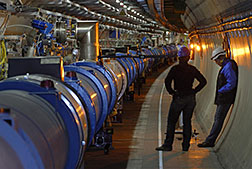- Number 394 |
- August 5, 2013
LHC discovers rare particle decay

The Large Hadron Collider
Physicists have discovered a new particle decay that gives them an indirect way to test models of new physics. Physicists working on experiments at the Large Hadron Collider have observed for the first time the rare decay of a particle made up of two kinds of quarks—anti-bottom quarks and strange quarks—into a pair of particles called muons.
The Standard Model predicts that the particle, called B-sub-s, will decay into two muons very rarely, only three times in every billion decays. However, this prediction assumes that the only particles involved in the decay are the ones physicists already know. If other, unknown particles exist, they might interfere, either making the decay happen more frequently than predicted or reducing the decay rate. Deviations from the predicted rate would firmly establish the presence of new forces or particles.
Scientists of the CMS and LHCb collaborations found that the B-sub-s decay follows the Standard Model’s predictions almost to the letter. While this is a major triumph for the predictive power of the Standard Model, this spells trouble for several alternative models, including a number of models within the theory of supersymmetry. The result still leaves room for other models of physics beyond the Standard Model to be correct. Scientists know that the Standard Model is incomplete, and they keep trying to find subatomic processes that disagree with it.
Physicists do not yet have enough data to make a statement about the rare decay of a related particle, the B-sub-d. The current analysis of LHC data shows that they will be able to gather evidence of rare B-sub-d decays after the LHC restarts in 2015 at higher energy.
DOE’s Fermi National Accelerator Laboratory serves as the U.S. hub for more than 1,000 scientists and engineers who participate in the CMS experiment. DOE and the National Science Foundation support involvement by about 2,000 scientists and students from U.S. institutions in the LHC experiments.[Kurt Riesselmann, 630.840.3351,
kurtr@fnal.gov]
